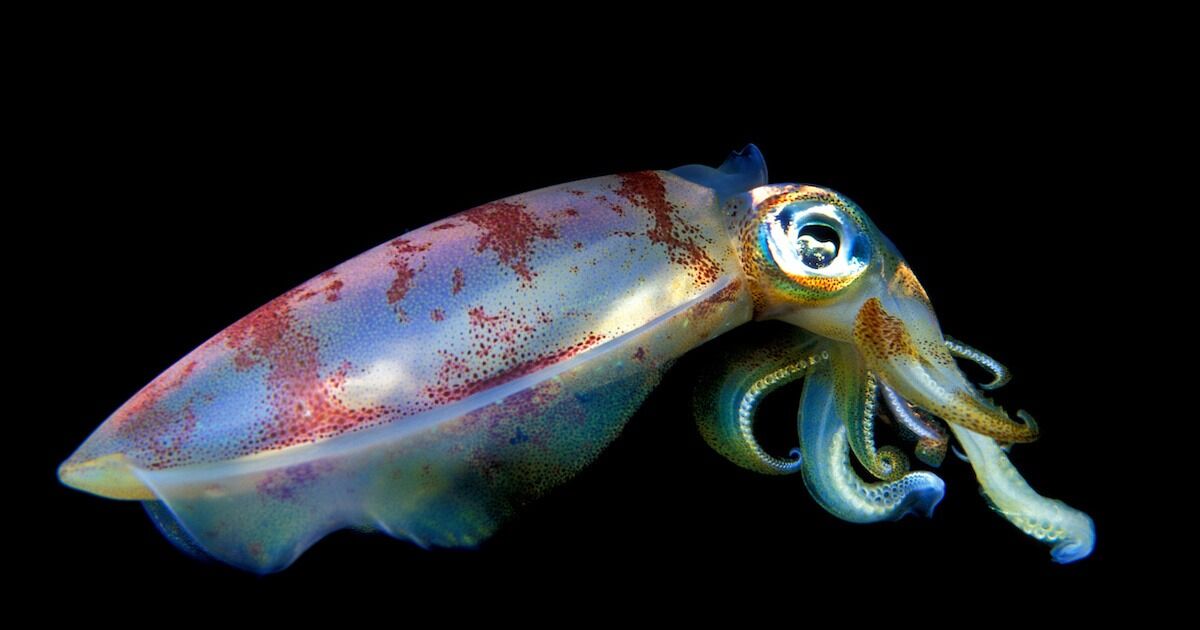
- Latin Name: Loligo (or Doryteuthis) opalescens
- Phylum: Mollusca
- Class: Cephalopod
- Family: Loliginidae
What Do They Look Like?
Pacific coast squid have a long, tapered mantle, with a distinct head, large eyes, and triangular fins protruding from opposite sides near the pointed tip. Also called opal or opalescent inshore squid, their flesh is translucent bluish-white, mottled with iridescent purple-green patches while at rest. But they can change colour to better suit their environment or mood. They have ten arms, two of which are club-shaped feeding tentacles, equipped with both suckers and barbed hooks. The other eight help to entangle and manipulate prey. Considered mollusks, squid are in the same category as both octopus and shellfish. They are mostly soft-bodied, but they have a rodlike internal shell, called a pen. Adults reach 6″ to 12″ long.
Where Do They Live?
BC’s most common squid species, they range from southern Baja to southeastern Alaska, mainly in intertidal zones, but occasionally down to 500 m.
What Do They Eat and What Eats Them?
Every day, these cannibalistic carnivores eat up to 14% of their body weight in fish, crustaceans, and other squid. They are primarily nocturnal, hunting mostly by sight, in cooperative squads that lurk in dark fringes around brightly illuminated water. When something edible shows up, they dart out, grab it, and drag it back to the shadows. Using intelligent ambush tactics, and swift, powerful tentacles, they easily overwhelm prey that is too large to fit into their small mouths— until they cut it up with their sharp, parrot-like beaks. After that, these little aquatic meat-grinders further pulverize their victims using a rough, tonguelike radula, and multiple rows of sharp, tiny teeth.
Squid
What Moves Them?
Squid aren’t solitary. They school together to achieve common goals, like nourishment and reproduction. Depending on where and how fast it wants to go, a squid has options for locomotion. It can swim slowly in any direction by undulating the fins on the sides of its mantle, or it can jet backward by shooting water out of its mantle cavity through its siphon.
What Helps Them Survive?
When sophisticated camouflage techniques, badass tentacles, and a razor-sharp beak are not adequate to elude an adversary, a squid also has in its arsenal an ink gland, which deploys a dark cloud to hinder a pursuer’s senses of both sight and smell.
How Do They Grow and Reproduce?
When conditions are right, multiple squads of squid will converge onshore to spawn, creating vast communal mounds of egg-strings, then dying within a few weeks.
Once a 6- to 9-month-old male’s colourful displays of anatomic superiority attract a similarly-mature female’s attention, he uses a special copulatory pad on one of his left arms to reach into his mantle cavity, grab a long, thin spermatophore packet out of his penis, and poke it up into the female’s mantle cavity. There, it meets up with a case of about 200 eggs, wrapped in layers of protein and beneficial bacteria. The female attaches these to the sand, then leaves them to hatch when they’re ready, which is 3 to 8 weeks later, depending on water temperature—if they don’t get eaten by bat stars first.
The 3-mm-long paralarvae begin swimming right away, hunting zooplankton nightly at 15 m depths, and retreating to 30 m by day. Considering their relative size, this is similar to a human preschooler running 15K each day.
What Are They Known For?
Most familiar as calamari (calamaro is Italian for “squid”), another common name for this species is the California Market Squid. In the 1860s, Chinese— and later Italian—fishermen caught them in the Monterey Bay and sold them in San Francisco.
How Else Are They Special?
A squid has three hearts, blue blood, and a complex donut-shaped brain encircling its esophagus. Its pen is made of chitin—a strong polymer also found in insect exoskeletons and the cell walls of fungi—which has proven useful in medicine, industry, and biotechnology. Recently, scientists have proposed that waste chitin from food production be combined with soil from Mars to create a virtually indestructible building material for structures, tools, etc. Squid have always looked like eerie aquatic aliens. Soon their inner parts might actually converge with extraterrestrial elements and take on new forms!
This article appeared in Island Fisherman Magazine. Never miss another issue—subscribe today!
Visit the Store
$34.99
$34.99
Featured Catch
Joel Unickow halibut (Photo: Rob Frawley Lucky Strike Sportfishing Tofino)




